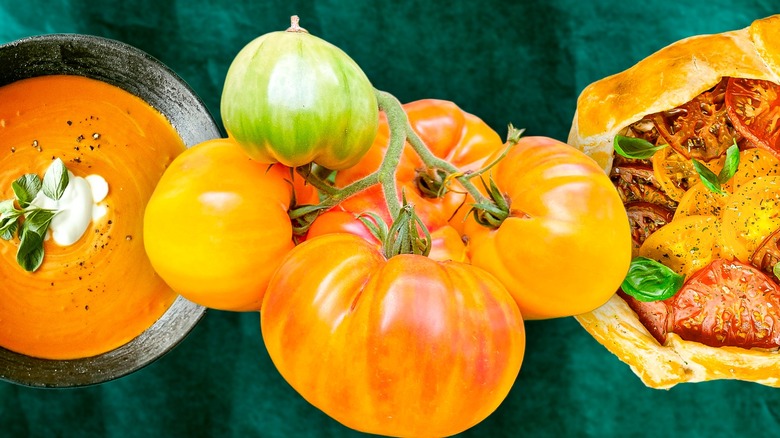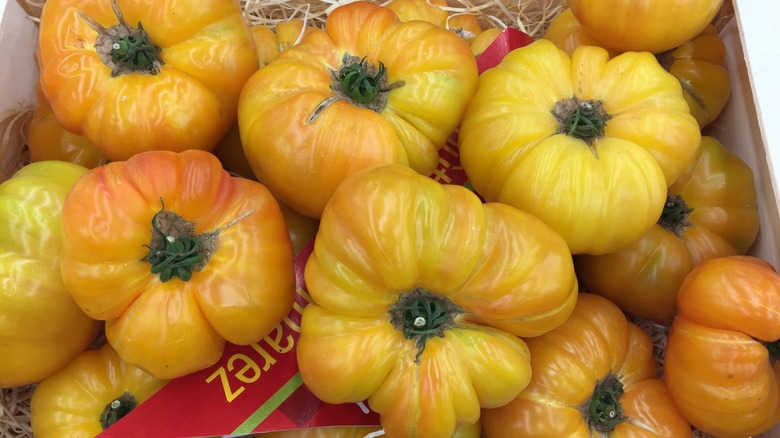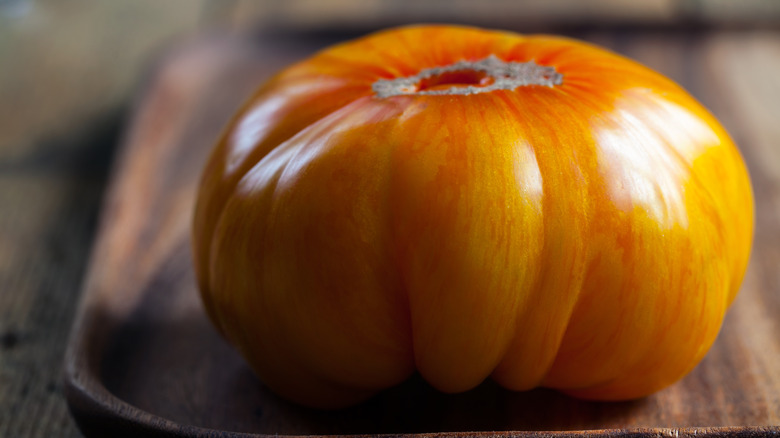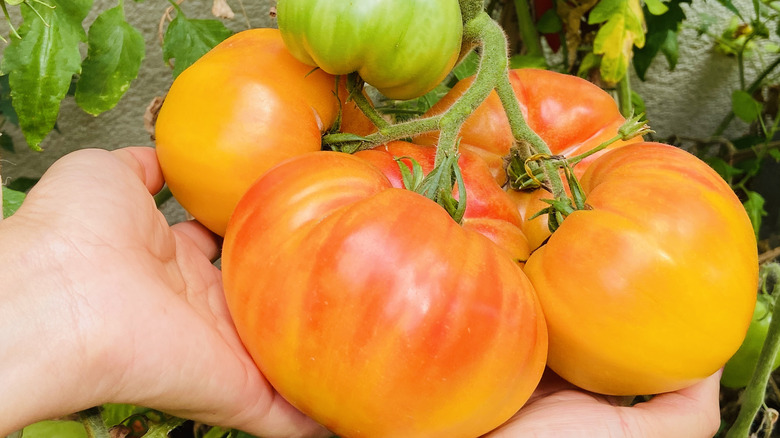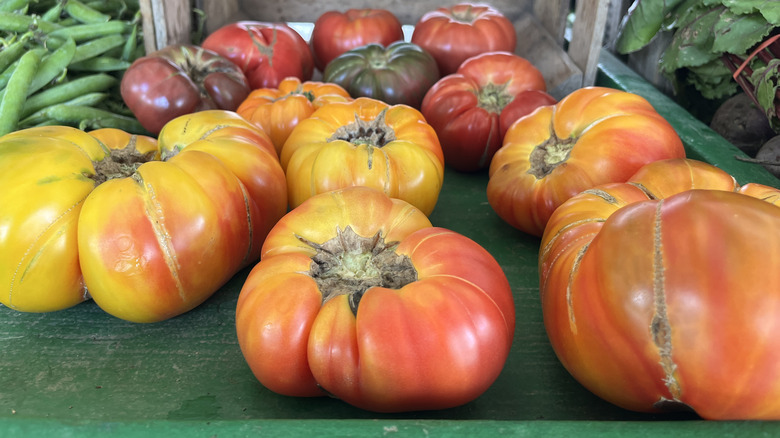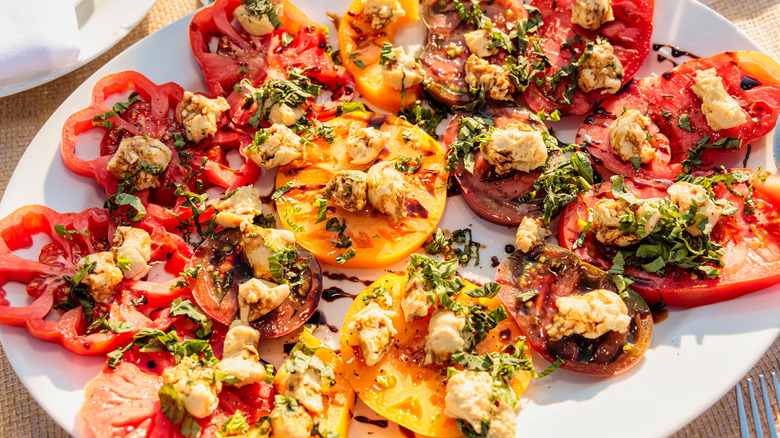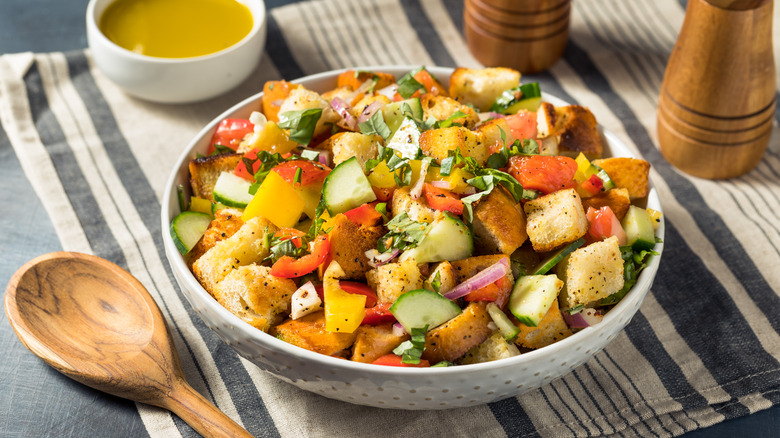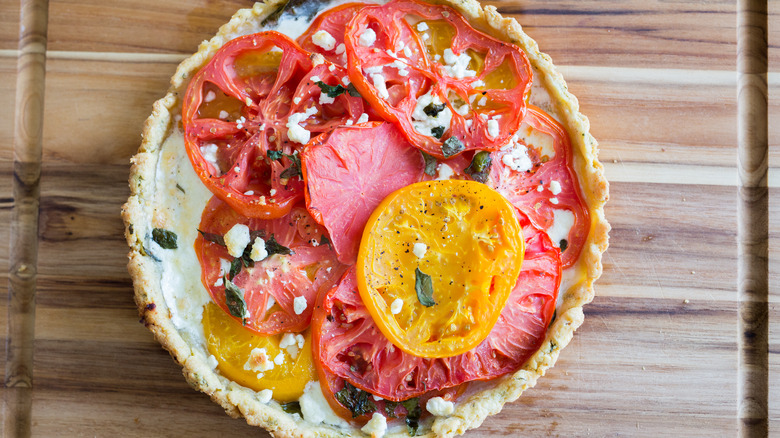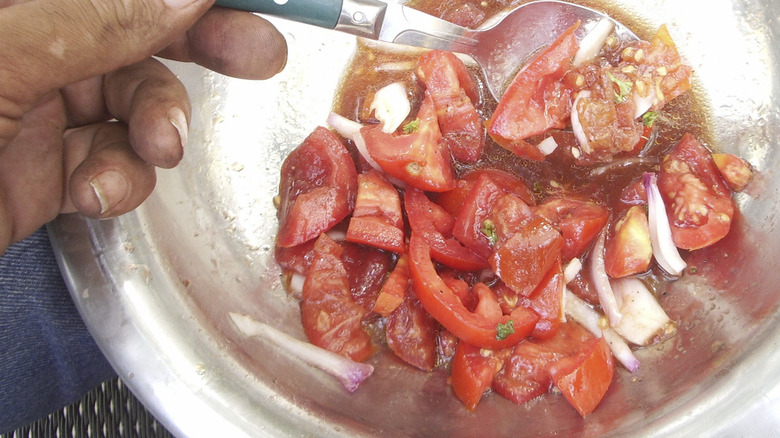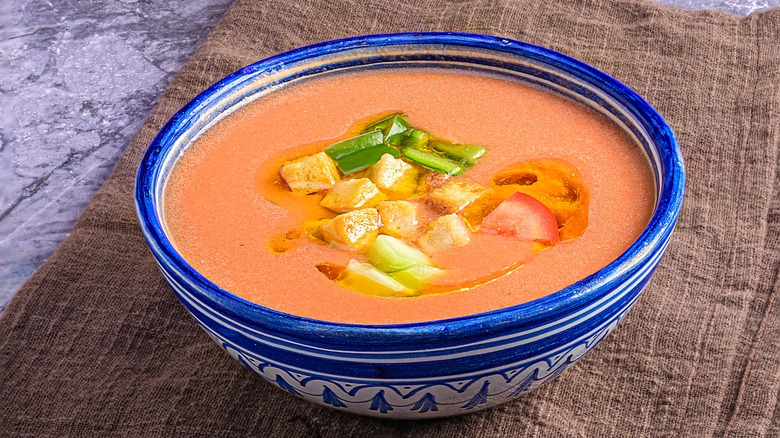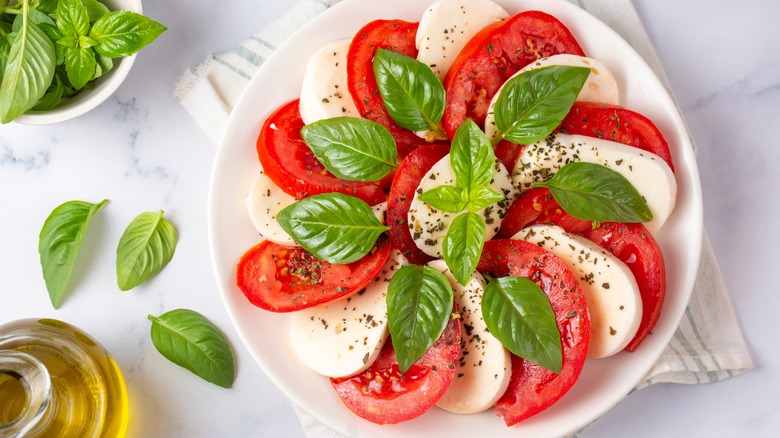What Are Pineapple Tomatoes And How Do You Best Use Them?
Fruits and vegetables are available year-round now, thanks to modern supply chains, but summer still brings a few exceptional offerings with it. There's just no substitute for a juicy peach fresh from the tree, or a tomato ripe from the vine.
Sadly, peaches won't grow where I live, but as a longtime gardener I really love growing heirloom tomato varieties. They aren't always pretty, but the best of them pack flavors and colors that you just can't get from a commercial supermarket tomato. As a trained chef and former restaurateur, I also have a pretty good handle on how to use them in the kitchen.
One intriguing heirloom tomato is the so-called "pineapple tomato," a longtime favorite in many warmer climates. Its color and flavor are unusual and exceptional, so if you live in an area where you can grow them — or find them at a farmer's market — they're well worth trying. Here's what you need to know about them, and how to use them to the best advantage.
What are pineapple tomatoes?
Pineapple tomatoes are a fine example of what heirloom tomatoes are all about. They are typically open-pollinated varieties, not hybrids, so the seeds can be saved and passed down from generation to generation. That's where the "heirloom" part comes in. There's no consensus over how long they need to be around before they're considered to be heirloom tomatoes. Fifty years is a common figure, but that's only a guideline.
The pineapple tomato fits the profile, nonetheless. Its origins are murky, but it's generally thought to have been grown first in Kentucky or Ohio. Nutritionally, it's hard to know how pineapple tomatoes, or heirlooms in general, differ nutritionally from regular supermarket tomatoes. One study carried out in Turkey found only minor differences in various antioxidants between heirloom, beefsteak and cluster tomatoes, but otherwise comparative data is scarce. Tomatoes in general are high in vitamin C, fiber, potassium, vitamin K, folate, and the antioxidant lycopene.
It seems reasonable to believe that a fully vine-ripened tomato might contain more nutrients than a supermarket tomato that's picked early and ripened artificially. There's no hard evidence to support that assumption, though.
What are pineapple tomatoes like?
Pineapple tomatoes are a big beefsteak-style slicing tomato, often reaching weights between 1 and 2 pounds each. It's described as a bicolor tomato, but that sells it short: they'll show varying shades of red, pink, yellow and orange from one tomato to another.
The "pineapple" part comes from the golden hues it often shows and its ribbed fruit, which to some forgotten observer's eye resembled the ridges on a pineapple's sides. Its flavor is sweet and mild, with minimal acidity and a slightly citrusy fruitiness. Some claim that there's a hint of pineapple in the flavor, but that may be just the power of suggestion.
Like many heirloom tomatoes they'll vary widely in size and shape, and they're frequently lopsided or otherwise fall short of the uniformity you'd see with commercial tomatoes. They have thin skins and they're very meaty, with relatively few seeds. That combination–along with their stellar flavor–makes them an uncommonly good slicing tomato.
Growing pineapple tomatoes
Getting your hands on some pineapple tomatoes isn't a straightforward proposition. You may be able to find them in farmer's markets in your area, but otherwise your best bet is to grow them yourself (unless you know a tomato-loving master gardener). They're often ranked among the tastiest heirloom varieties, so they're worth the effort.
Broadly speaking, tomatoes can be "determinate" or "indeterminate." Determinate tomatoes fruit early, and all at once, and then stop. Indeterminate tomatoes grow and produce until the frost kills them. Pineapple tomatoes are indeterminate, and they need a long growing season. They'll produce heavily if you start them early enough, or have reliably long, warm autumns.
They grow long vines and produce heavy fruit, so they'll need very sturdy support in the form of stakes or tomato cages. They're also heavy feeders, so plant them in beds that have been enriched with plenty of compost and organic material, and plan to fertilize them regularly during their growing season. Avoid fertilizers high in nitrogen (the first number on the label), because that stimulates foliage growth rather than fruit. If you aren't an experienced tomato grower, reach out to your local extension service for guidance and tips that work in your specific growing area.
Using pineapple tomatoes
Here's the thing about pineapple tomatoes (and heirloom varieties in general) as opposed to commercial varieties. Commercial tomatoes are bred to be sturdy and long-lasting, and stand up to shipping and handling. Heirlooms just have to taste great when they're fresh from the vine. They may also be colorful or have an interesting shape, but that's just a bonus.
This means that there are a couple of compromises involved. In this case, pineapple tomatoes are large and heavy but have an unusually thin skin. That means you'll need to handle them carefully, and ideally store them in a single layer once they're ripe (because they may burst under their combined weight, if you stack them). Keep them on a counter or windowsill until they're fully ripe, and use them up while they're at their peak.
Contrary to popular belief I've found that it's okay to refrigerate tomatoes after they reach full ripeness, to prolong their life. Like cheese, you just need to let them come back to room temperature before you serve them. Heirloom tomatoes can be used in any recipe that calls for fresh tomatoes, but – like other chefs – I recommend prioritizing dishes where the tomatoes' own bright, fresh flavor is front and center.
Grill your pineapple tomatoes
If vine-ripened tomatoes are one of the great pleasures of high summer, then so is firing up the grill every day. It makes perfect sense to combine those two things, though tomatoes might not currently be high on your "things to grill" list.
If that's the case, you're in for a surprise. Grilled heirloom tomatoes are one of those perfect summer side dishes. They're super-easy, quick, and go with just about anything. Pineapple tomatoes are an especially good candidate for this use, because of their size, small seed cavities and unusual meatiness.
It's not a complicated dish. Large pineapple tomatoes can be sliced horizontally into three or sometimes four thick slabs, while smaller ones should be halved. Drizzle them with oil, season them, and grill them for three or four minutes over high heat until they're well marked. Turn them for another minute or two, just until they're slightly softened all the way through, and you're done. They're great as-is, or enhanced with minced fresh herbs, a vinaigrette, or crumbled cheese.
Toss together a pineapple panzanella
Making broad generalizations about Italian food is a fool's game, because the country's culinary culture is so diverse. That said, there's a strong emphasis on simplicity that underpins many of the best regional dishes.
One of those deceptively simple dishes is panzanella, a simple salad of herbs and really ripe tomatoes, tossed with a vinaigrette and stale (or toasted or dried) bread. The bread soaks up the juices of the tomatoes, the vinaigrette and the herbs' flavors. Pineapple tomatoes, with their distinctive color and flavor, are perfect for this salad. The bread softens as it sops up the juices, and helps make the salad more filling.
It's a simple but satisfying salad, though anyone who's trying to go light on carbs might prefer something without bread in it. In that case, maybe shift gears and go with Ina Garten's "hot days" tomato salad, instead. It's just as simple–heirloom tomatoes, a vinaigrette, and Roquefort cheese–but it's friendlier to low-carb eating, and the cheese adds a welcome dash of protein.
Make a tart or galette for a light lunch
Summertime lends itself to a lot of light lunches. Partly that's because a heavy mid-day meal isn't especially comfortable when the weather is hot, and partly because most of us want to avoid heating up our kitchen whenever possible.
For a lot of us, that means salads, sandwich plates and maybe quiches. But if you have a garden full of pineapple tomatoes, or bought a basket of them at the farmer's market, I can really recommend jumping on the opportunity to make some kind of tomato-based tart or galette. Your kitchen won't get too hot if you make it in the evening or morning, when things are relatively cool, or if you use a countertop oven or toaster oven.
You may already have a family recipe for a tomato pie in your repertoire. If not, we have a few really tasty ones for you to try. Pineapple tomatoes would be really great in this heirloom tomato and ricotta tart, for example, or cheddar heirloom tomato pie. For something to really knock 'em dead on Insta, this heirloom tomato galette is the exact kind of "rustic in a really photogenic way" that gets noticed.
Build that best-ever BLT
Tomatoes are a mainstay topping on sandwiches, and for ordinary sandwiches or wraps ordinary tomatoes are just fine. But if you want your tomato to be the star of the show, you need to pick a sandwich which, like a BLT, puts it front and center.
If you have ripe pineapple tomatoes (or other heirlooms) on hand, consider it an opportunity to make the BLT of a lifetime. Start with good bread, and a perfectly ripe pineapple tomato. Cook and drain some thick-cut artisan bacon, the best you can put your hands on. Finally, spread your toasted bread with good mayonnaise, and layer on the tomatoes, bacon, and some garden-fresh lettuce. Don't forget to season the tomatoes lightly with salt and pepper. It's heaven (and summer) on a plate.
When the tomatoes are really good, I often skip the bacon and lettuce and just enjoy the tomatoes on toast. Sometimes I make a closed sandwich, and sometimes I go open-faced so I can fit more tomato onto my two slices. All I add is a smear of mayo and the salt and pepper. That's often my daily lunch at this time of year, and in fact I picked a big, perfect heirloom yesterday that will go on toast (from my home-baked bread) about an hour after these words are typed.
Marinate the tomatoes
Some of the best side dishes are things you can prepare and have ready in your fridge, ready to go when you need them. Most chefs have a handful they turn to, especially in summertime when vegetables are at their best. Personally I'm fond of marinating vegetables, and heirloom tomatoes are my top choice.
Marinated tomatoes are easy and very tasty, especially if you have ripe pineapple tomatoes to use. Just pair them with an oil and a vinegar that will complement them, rather than overpowering them. Light-tasting cider vinegar, balsamic and mild wine vinegars are all good choices. I'm partial to sherry vinegar or champagne vinegar in this kind of use. They're a bit pricier, but you won't use much so it goes a long way.
As for the oil, olive oil is the obvious choice. They can be neutral, fruity or peppery, so taste yours on a slice of the tomato before you commit to it. When in doubt, go with something neutral and let the tomatoes shine. If you have a few gourmet oils on hand in your pantry, something like walnut oil can really elevate the tomatoes. Slice them, toss them with the oil and vinegar, season them with salt and pepper (and maybe a fresh herb or two, if you wish) and put them in a jar or bowl for at least overnight. Serve them alongside salads, or with a cheese plate, or just eat them as a snack with crusty bread.
Whip up a quick (not simmered) heirloom tomato sauce
When tomatoes first start ripening in your garden, you'll want to enjoy each and every one just as it is, fresh from the vine. But by mid-summer the tomatoes are usually coming faster than you can deal with them, and it's time to think of other ways to use them up.
One obvious choice is tomato sauce. Most recipes call for slow simmering, which isn't the best use for pineapple tomatoes and other heirlooms. Plum or "paste" tomatoes are your friend, there. It's not that heirlooms don't make a good sauce, but the long cooking time dulls their bright, wonderful flavors. One alternative is this no-cook tomato sauce, which does the exact opposite, though I usually opt for a quick-cooked version.
I like to peel my tomatoes first. You can find special serrated peelers for this, but the boiling-water method is my go-to and it's definitely easier with ribbed and irregular-shaped tomatoes like these. I cut the tomatoes in half and squeeze out the seeds and jelly, then chop them coarsely. Then, I sweat some onions in a Dutch oven or deep skillet until they're translucent, and add a generous handful of minced garlic, and finally the tomatoes. I cook them until they're just soft enough to start falling apart, and then add the cooked pasta, some fresh basil, and a light sprinkle of Parmesan (not enough to overwhelm the tomatoes' flavor).
Make the gazpacho of your dreams
The Mediterranean region is well known for its repertoire of light, refreshing hot-weather foods. Greek cuisine has its mezze, Italy has its various antipasti, and Spain is well known for the cold soup known as gazpacho.
Gazpacho is basically summer in a bowl. Tomatoes, cucumbers and bell peppers are the core ingredients, and a good rule of thumb is that the better the tomatoes, the better the soup. If you have a kitchen counter filled with pineapple tomatoes, you're ready to make the gazpacho of your dreams. It's not a complicated process, though, of course, there are a few basic mistakes to avoid and tips to follow.
Old-school gazpacho called for pounding the vegetables in a big mortar and pestle, while newer recipes puree them in a blender. I like to use my food processor, instead. It hits that sweet spot of low effort but more texture, which I find appealing (I lean to the camp that considers it more a "liquid salad" than a soup). My biggest tips are to seed the tomatoes and cukes before you add them, and not to skip the bread. It's essential to the dish's character, and makes it a bit heartier.
Make a pineapple tomato Caprese
This may have been the very first thing that sprang to your mind as a dish to make with fresh tomatoes, but I left it for last because it seemed a fitting way to finish. There are plenty of tomato-based salads out there, but a Caprese is the classic, the simple and elegant "little black dress" of tomato dishes.
It's one of those deceptively simple dishes that leans heavily on the quality of its ingredients. You want the best-tasting tomatoes you can get (heirlooms for the win!), fresh mozzarella, good olive oil, fresh basil leaves, and a sprinkling of salt. That's it. Many recipes call for vinegar as well, but that's not the canonical version. There's nothing wrong with adding a few drops of balsamic if you want to, but the added vinegar is a crutch that's intended to brighten up tomatoes that aren't quite good enough. You don't need that, with fresh pineapple tomatoes.
There's some finesse involved, naturally. Ina Garten emphasizes slicing your tomatoes and mozzarella to the same thickness, for the best presentation. Given how large pineapple tomatoes are, I'd suggest choosing smaller specimens that are closer to the diameter of your mozza. If that's not an option you can halve the tomatoes vertically, and layer them around your plate so that the cut side is hidden. With pineapple tomatoes you'll lose the patriotic red-white-green Italian flag color scheme, but that's not nearly as important as how good it will taste.
